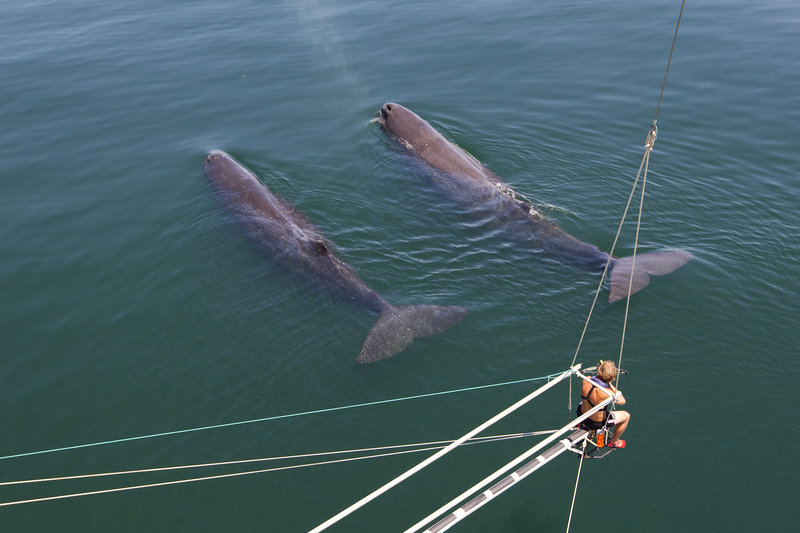PORTLAND — A research team from the University of Southern Maine has returned after four months at sea doing first-of-its-kind research on how the Gulf of Mexico oil spill affected whales.
John Wise, a professor of toxicology and molecular epidemiology, and 16 students spent their days aboard the Odyssey, a 93-foot sailboat, taking cell samples from humpback, Bryde’s and sperm whales in the Gulf and the Atlantic.
They grew the cells in Wise’s cellular molecular laboratory aboard the research vessel owned by the Ocean Alliance, a Massachusetts nonprofit that shared the cost of the trip – about $200,000 – with USM.
“This was the first time whale cells were grown at sea,” said Wise.
This winter, they will extract DNA from the cells to look for possible damage from the oil and the chemicals that were used to break up the oil slick. They expect to have preliminary results by the spring, and will use them as a baseline for ongoing research.
The researchers plan to return to the region for the next four summers to collect more cell samples.
The Deepwater Horizon oil rig exploded on April 20, causing the largest offshore oil spill in U.S. history.
Preliminary results from the USM researchers show that the dispersants cause DNA damage in human cells, which can lead to cancer, reproductive deficiencies and other problems, Wise said.
He expects it will take some time for the dispersants and oil to make their way through the food chain and show up in whales. He expects the chemicals may appear first in the Gulf’s population of 15 to 20 Bryde’s whales, which feed on plankton, followed by fish-eating whale species.
“It will get worse,” he said.
Wise said the whale populations in the Gulf are vulnerable.
Because sperm whales reproduce so slowly, he said, the death of just three or four of the 1,600 living in the Gulf could be enough to tip the species into spiraling population decline.
The students described the expedition as an incredible adventure.
“I hadn’t seen any whales before,” said Matt Braun, a junior chemistry major from Cape Elizabeth.
When the crew members encountered their first whales, Braun said, they were so excited that they almost forgot to collect the cell samples.
A typical day started with a whale search. Students would look for whales from the crow’s nest, 78 feet above the deck, while the boat dragged a microphone capable of picking up whale sounds.
Once whales were spotted, a student armed with a crossbow would creep out to the end of the bowsprit to shoot a 2-foot-long dart at a whale. Each dart nipped off a small sample of flesh, while other crew members made a photo ID of each whale.
Each sample would be rushed down to the lab, where other students processed it.
Wise’s children, John Jr. and Cathy, both biology majors at USM, and his wife, Sandy, were part of the research crew.
One surprise, they said, was how little oil they encountered. Wise spotted a few tar balls on a beach, and his son caught two fish that were filled with oil. But they didn’t see oil on the surface of the water, even when they were within a few miles of the spill site.
Wise said the crew encountered few whales east of the spill. He said he suspects the whales were trying to avoid the many boats that were involved with the cleanup.
Staff Writer Beth Quimby can be contacted at 791-6363 or at: bquimby@pressherald.com
Send questions/comments to the editors.




Success. Please wait for the page to reload. If the page does not reload within 5 seconds, please refresh the page.
Enter your email and password to access comments.
Hi, to comment on stories you must . This profile is in addition to your subscription and website login.
Already have a commenting profile? .
Invalid username/password.
Please check your email to confirm and complete your registration.
Only subscribers are eligible to post comments. Please subscribe or login first for digital access. Here’s why.
Use the form below to reset your password. When you've submitted your account email, we will send an email with a reset code.